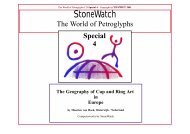petroglyphen im valle del encanto - StoneWatch
petroglyphen im valle del encanto - StoneWatch
petroglyphen im valle del encanto - StoneWatch
Sie wollen auch ein ePaper? Erhöhen Sie die Reichweite Ihrer Titel.
YUMPU macht aus Druck-PDFs automatisch weboptimierte ePaper, die Google liebt.
<strong>im</strong>ental stage. In the relevant literature, the dating problem of a<br />
specific site is often s<strong>im</strong>plified to the question: who made them,<br />
Arawaks or Caribs ?<br />
COMPASS BEARING<br />
We noted down the compass bearing of engraved surfaces in<br />
214 cases, on a sixteen points scale. S<strong>im</strong>plification of these<br />
numbers to a four quadrant scale results into the following numbers:<br />
North: 60; East: 54; South: 41; West: 59. From these data<br />
it follows that Lesser Antilles petroglyphs do not show a preference<br />
for a specific orientation. This rules out the phenomenon<br />
of a <strong>del</strong>iberate and integrate East orientation, which is often reported<br />
in Petroglyph literature, where it is associated with sun<br />
worship.<br />
AVERAGE DIMENSIONS<br />
A calculation from our data stock shows that the horizontal and<br />
vertical d<strong>im</strong>ensions of an average Lesser Antilles petroglyph are<br />
23 and 26 cm. This is rather small for American Indian engravings.<br />
By way of comparison: petroglyphs in Surinam average<br />
47 x 51 cm, which means that they are four t<strong>im</strong>es as large. The<br />
small d<strong>im</strong>ensions in our area may be explained by the predominance<br />
of the S<strong>im</strong>ple Face motif.<br />
ROCK SPECIES<br />
The samples we collected from the engraved rocks were determined<br />
by Prof Dr. S.B. Kroonenberg, Wageningen University,<br />
The Netherlands. He characterized the material in general as follows,<br />
„Rather compact volcanic rocks, for the greater part lavas;<br />
some somewhat coarse grained rocks possibly from domes. The<br />
composition is intermediate (andecitic to dacitic)“.<br />
From these data it follows that the petroglyph makers in the<br />
Lesser Antilles neither chose the weakest rocks for easiest engraving,<br />
nor the hardest ones for max<strong>im</strong>al duration of the drawings,<br />
but that they picked out the more massive, non-fossile rocks.<br />
COMPARISON OF LESSER ANTILLES PETROGLYPHS<br />
WITH THE ENGRAVINGS OF THE GREATER ANTILLES<br />
Lesser and Greater Antilles petroglyphs show a number of s<strong>im</strong>ilarities<br />
which point to cultural contacts in prehistoric t<strong>im</strong>es. On<br />
the other hand, diss<strong>im</strong>ilarities exist which point to an individual<br />
character of both regions.<br />
S<strong>im</strong>ilarities:<br />
1. The typical N. E South American rock art figures mentioned<br />
in the next paragraph (curled shoulders, etc.) are absent both in<br />
the Lesser and in the Greater Antilles.<br />
2. Spirals and matchstick figures (Fig. 3) in both regions do not<br />
occupy the dominant position they have on the mainland. In the<br />
Greater Antilles they are scarce; in the Lesser Antilles they are<br />
practically absent.<br />
3. Both in the Greater and in the Lesser Antilles the majority of<br />
the drawings consists of s<strong>im</strong>ple faces (Fig. 3); in the remaining<br />
corpus, elaborate faces (Fig. 3) and complete anthropomorphs<br />
dominate. This dominating position of anthropomorphic motifs<br />
does not exist on the mainland.<br />
6<br />
Fig. 3. Some Petroglyph Motifs. 1. S<strong>im</strong>ple faces, 2. Elaborate faces, 3.<br />
Curled shoulders, 4. Double spirals, 5. Double reversed spirals, 6.<br />
Concentric circles, 7. Footsteps, 8. Suns with rays, 9. Framed crosses,<br />
10. Matchstick figures, 11. Frog men, 12. Men with concentric diamonds<br />
bodies, 13. Eye and ear in one piece, 14. Headfeet people, 15.<br />
Double ears, 16. Head on rope.<br />
Fig. 4 Ball Court Figure, Puerto Rico<br />
Diss<strong>im</strong>ilarities:<br />
1. The elaborate anthropomorphic<br />
figures on ball court slabs<br />
(Fig. 4) are specific for the<br />
Greater Antilles. Even the ball<br />
court slabs in St Croix do not<br />
have this type of human figures.<br />
2. Specific for the Greater<br />
Antilles are, next to these ball<br />
court figures: barbed faces, framed<br />
crosses, terrifying faces<br />
with bulging eyes, and rabbitlike<br />
figures with upstanding<br />
pointed ears (Fig. 6). It is striking<br />
that these motifs do not<br />
occur in the Lesser Antilles, with<br />
the exception of Grenada which<br />
has them all.<br />
This might point to a direct cultural<br />
contact between Grenada and the Greater Antilles in prehistoric<br />
t<strong>im</strong>es. However, archaeological investigations based on<br />
other prehistoric remains do not support this supposition.<br />
Fig. 6. 1. Barbed faces, 2. Terrifying faces, 3. Rabbits, 4. Faces with<br />
small circles on the contour line.<br />
3. In the Greater Antilles figures occur showing faces with small<br />
circles (four or more) on their contour line (Fig. 6). In some<br />
cases the whole outline of the face is occupied with these circles.<br />
These figures occur neither on the mainland, nor in the<br />
Lesser Antilles.
















